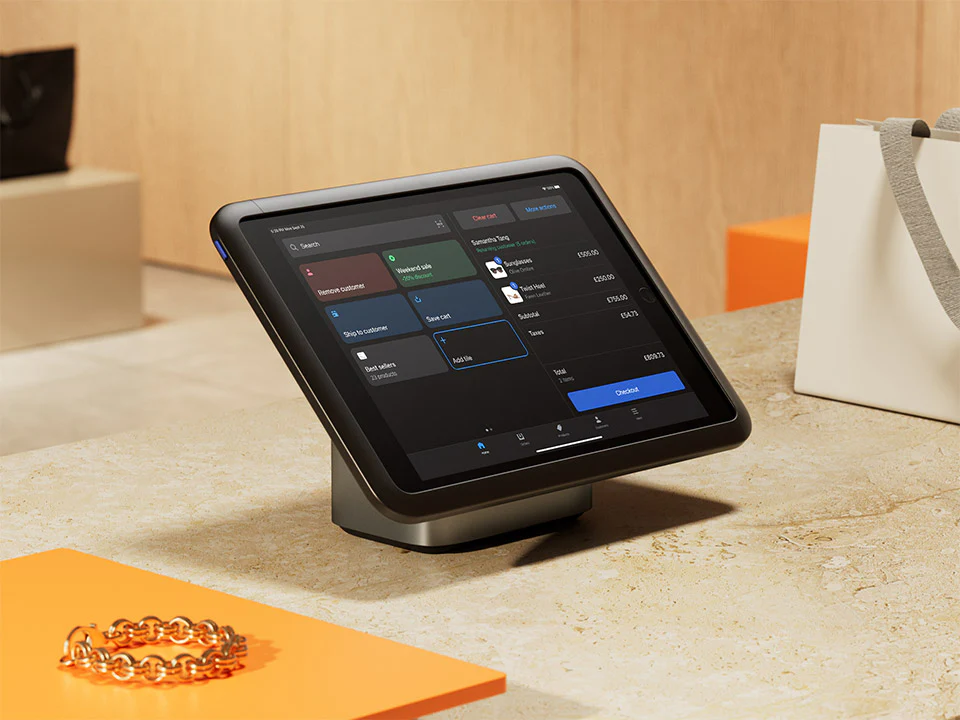The early years of opening a retail store may involve manually managing inventory. You may use a messy spreadsheet or run around a stock room, pen and paper in hand, to do physical inventory counts.
Your stock levels may not match what’s in your POS (point of sale) system, it might take hours to fulfill orders each week, or you can’t replenish best-selling inventory to match demand. Sound familiar?
Your retail business deserves an upgrade. Cue the arrival of an automated inventory management system. This post will highlight its benefits and core features and explain why you need one.
What is an automated inventory management system?
An automated inventory management system lets retailers use tech to automate the flow of goods within their business. Instead of manually managing goods, automated inventory management systems track products in real-time.
The system uses software to monitor what's in stock, what's running low, and what needs reordering. Automated inventory management saves time, reduces human error, and improves efficiency.
How automated inventory management systems work
Automated inventory management systems work like smart assistants for businesses. They tap into multiple tools to keep an eye on goods. Here's how:
- Barcode scanning: Each item has a unique barcode. When it’s scanned, the system identifies it and updates the inventory count.
- Software: A program tracks all the products and displays what's in stock, what's sold, and what needs reordering.
- Real-time updates: The system updates immediately when an item sells, or new stock arrives, so inventory is always up-to-date.
- Reports: It creates reports to show which products are popular, which are not selling, and when it's time to order more.
- Integration: It syncs with other systems, like your POS and online store, so everything connects and runs smoothly.
The benefits of automated inventory management
An automated inventory management system comes with plenty of benefits for retail businesses. Aside from saving you from doing physical stock counts, automated inventory management can boost your retail business in several ways:
Prevent stockouts
With automated inventory management systems, you can view real-time stock data and see how many items you have at any time. You can set up reorder points for specific items that are running low and restock them before they run out.
The system also analyzes historical sales data to forecast demand, helping you order the right amount of stock for busy shopping seasons. Staying on top of your inventory prevents empty shelves and keeps your customers happy.
Reduce costs
You can reduce costs in several ways with an automated inventory management system. First, it minimizes the chances of overstocking or understocking, which can result in wasted resources or lost sales.
Tracking inventory levels in real-time means you’ll only order what you need when you need it. This reduces inventory costs and the risk of discounting or disposing of unsold stock. Plus, by automating tasks like tracking and reordering, the system saves time and labor costs, letting your team focus on core competencies.
Accurate forecasting
Instead of guessing at future demand, you’ll have a clear idea of how much stock to order. Automated inventory management systems use data and analytics to predict future sales and inventory needs. It looks at data like past sales trends and seasonal fluctuations to forecast how much stock you'll need in the coming weeks or months. Planning ahead and ordering the right products will help you avoid shortages and excess inventory.
Fulfill orders faster
An automated inventory management system helps you fulfill orders faster by streamlining the process from start to finish. When an order comes in, the system immediately checks if the item is in stock and where it's located. This reduces the time spent searching for products and speeds up the picking and packing process.
With Shopify POS, in-store, you can tap into the ship-to-customer feature, turning your physical store into a convenient endless aisle. In the case of Bared Footwear, if one store doesn’t have a customer’s color or size in stock, staff can close the sale and ship the order to their home address from any store location with stock on hand in one simple workflow.
Plus, email carts let customers consider and finish their purchase online with a pre-loaded cart sent to their email by store team members.
“These fulfillment options wouldn’t be possible if our store inventory, orders, and checkout wasn’t linked to our online store checkout like it is with Shopify,” says Alexandra McNab, Bared Footwear’s Chief Operating Officer. “It’s a much better experience for the customer and helps secure sales that may have otherwise been lost.”

The system can also prioritize orders based on urgency or customer preference, ensuring that important shipments go out first.
📚Learn: Inventory Management: Everything You Need to Know (2024)
Eight features to look for in an automated inventory management system
Not sure where to start in your search for an automated inventory management system?
Whichever system you choose, make sure it has the following eight features:
Real-time inventory data tracking
This feature keeps an eye on your stock levels 24/7. It updates instantly when items are sold, returned, or restocked. You’ll always know exactly what you have and where it is so you can make accurate stocking decisions.
Demand forecasting
Look for an automated inventory system that uses past sales data and trends to predict future customer demand. These insights help you see what your customers will want in the coming weeks or months, so you stock up on the right products at the right time.
Multi-location inventory management
Multi-location inventory management is a must-have feature if you store products in different places. It lets you track and manage your stock across multiple warehouses, stores, or online channels, all from a central system.
No matter where it’s located, you get a complete view of your inventory, helping you make better stocking decisions and how to fulfill orders efficiently. Multi-location inventory management allows you to move products between locations to meet demand and reduce shipping costs.

Stock alerts
Stock alerts act like a warning system, notifying you when inventory levels are getting low or when you're running out of a popular item. This way, you can reorder stock before it's too late, preventing stockouts and keeping your customers happy.
Stock alerts can be customized to your needs, so you get notified exactly when you want, whether it's when stock drops below a certain level or when it's time to reorder based on sales trends. You're always one step ahead with stock alerts, so your shelves are never empty.
Sales channel compatibility
You need your inventory management system to sync seamlessly with different sales channels, like your brick-and-mortar store, online shop, and social media platforms like Facebook.
With sales channel compatibility, you can manage all your inventory from one place, no matter where you're selling.
“The fact that Shopify offers a great ecommerce platform and POS system that work so well together for an omnichannel business like ours made it a very easy choice,” says McNab of Bared Footwear.
Footwear brand Wilding also found that Shopify POS integrations have helped them improve customer experience across offline and online channels. At their showrooms in Germany, customers can try on shoes before purchasing them in-store or online.
Shopify POS fully integrated Wildling’s online and offline purchases, removing the need for Wildling to manage multiple systems to track customers, inventory, and orders.

“The Shopify POS app allows customers to try and buy in our showrooms by generating an order in the Shopify store that is processed the same way as our online purchases—it easily integrates into one system,” explains Sebastian Feuß, the Company Lead.
“Shopify POS enabled us to reach different customer groups without huge investments in new technologies.” These integrations make it easier to keep track of stock levels, update product listings, and fulfill orders across all your channels. It’s also another way of providing a consistent shopping experience for your customers, whether they're buying in-store or online.
Preorders
Want to generate hype for an upcoming product launch? Preorder features let you take orders for products before they're in stock.
With preorders, you can build excitement and ensure your customers get their hands on popular items as soon as they're available. Preorders are also a way of gauging customer interest and planning your inventory so you have enough stock to meet demand.
Returns management
Dealing with product returns is part of managing a retail business, so ensure your inventory management software has built-in returns capability.
Your system needs to track returned items, update inventory levels, and process refunds or exchanges quickly. When your returns process is hassle-free, your customers will be more satisfied, too.
Some tools can also provide insights into why products are returned, so you can improve your products and reduce future returns.
Inventory reporting
Inventory reporting provides detailed analytics about your stock levels, sales, and overall inventory health. With inventory reporting, you can track your best-selling products, identify slow-moving items, and make informed decisions about ordering and pricing.
These reports can also help you spot trends, forecast demand, and optimize your inventory management processes.
Find the best automated inventory management system for your store
Implementing an automated inventory control management system will take your retail business to the next level. Instead of chasing your tail over endless manual processes, you’ll win back time and resources to put back into scaling up.
The best inventory management solution is one that makes your life easier. Whether you run a brick-and-mortar store or have a buzzing online shop, automated inventory management is the way forward.
Automated inventory management FAQ
What is the difference between manual and automated inventory management systems?
The difference between manual and automated inventory management systems is how they track and manage stock. Manual inventory management systems rely on people counting items and recording them by hand, which is slow and prone to human error.
Automated systems use technology like barcodes and software to keep track of everything in real-time, making the process more accurate and less time-consuming.
What are the 4 types of inventory management systems?
- Perpetual inventory system: Continuously updates inventory levels in real-time as sales and purchases happen, providing an up-to-date view of stock levels.
- Periodic inventory system: Inventory levels are updated at specific intervals, such as monthly or yearly, rather than continuously.
- RFID inventory system: Uses radio frequency identification (RFID) technology to track inventory, allowing for automatic and highly accurate tracking of items without the need for manual scanning.
- Barcode inventory system: Uses barcode scanning to track inventory, making it easier to monitor stock levels and movements.
What automation can be used to manage inventory?
To manage inventory effectively, you can use several inventory automation options:
- Automated data collection: Devices like barcode scanners and RFID readers automatically capture and update inventory information, eliminating manual data entry.
- Cloud-based inventory software: This software automates inventory tracking, order management, and reporting, providing real-time access to data from anywhere.
- Machine learning algorithms: These algorithms analyze historical data to forecast demand, optimize reorder points, and prevent stockouts or excess inventory.
- Automated order fulfillment: Systems that integrate with fulfillment centers or warehouses automate the picking, packing, and shipping processes, speeding up order processing.
- Ecommerce integration: Automation tools that sync inventory levels with online sales platforms ensure that stock information is consistent across all sales channels.
What is AI-based inventory management?
AI-based inventory management is a way of handling your stock using artificial intelligence. It uses data and machine learning to predict demand, optimize stock levels, and automate tasks like reordering. It helps retailers make better decisions, reduce waste, and keep customers happy.





